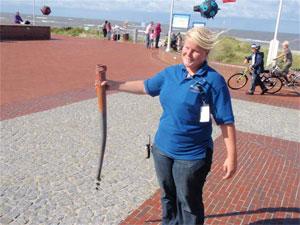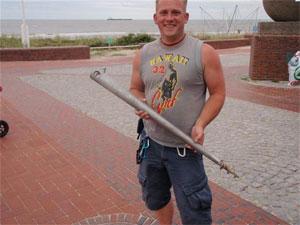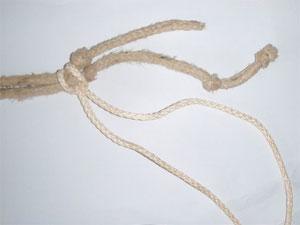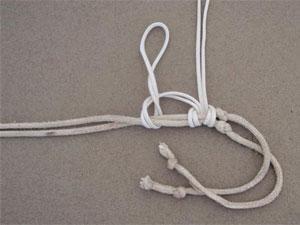Anecdotal Fallacies:
Wrong conclusions that come from being overly influenced by exceptional examples.
Photos of kites for example, and especially of soft kites.
By waiting until the wind is just right, the light and background are complimentary, and then discarding all shots in which kites are leaning a bit or not quite inflated, they can be made to look better than they actually are- even without photoshop massaging.
If we only knew these kites by seeing photos of them, we would have quite a false impression.
It’s selection bias- a type of sampling error- but, in this case it doesn’t fool us, because we know it’s happening and compensate accordingly- or do we?
Not all anecdotal fallacies are as harmless though.
A cause of the recent ‘great recession’ is thought to have been the case study system of teaching management used by many business schools- and particularly at Harvard.
In this approach, historical business experiences are studied as models for what to do, and what not to do in the future. This seems sensible; learning from the past experience of others, but it’s essentially anecdotal and is subject to selection bias By choosing highly leveraged businesses in the finance sector that had recently been wildly successful as role models, business schools caused this approach to spread quickly. Within a few years everyone (and their dentist) was piling into investment banking. What had worked well (for those in it at least) when this sector was just 10% or so of the total economy, bought the system down when it gobbled up 30% . Hardly surprising really; if I was a curmudgeonly conservative, I might be tempted to say that investment banking came up against the limiting factor that all parasites are subject to- damaging their hosts.
“Safety” culture also springs from an anecdotal fallacy- and it’s even more destructive of civil society than occasional excesses of greed.
When someone somewhere (the USA in this case) gets burnt by hot coffee (and wins a huge settlement against its provider), very soon every coffee provider in the world is required to take extensive precautions against this possibility; with a total cost to the general economy far in excess of the risk being mitigated. And it’s self perpetuating; the more rules and warnings there are, the more atrophied our awareness of danger becomes. If headstone messages again become fashionable, “but there was no sign” is sure to become a popular epitaph.
Kite fliers are increasingly caught by this net. Running kite events is now more about ‘compliance’ with extensive, arcane and frequently irrelevant ‘safety’ rules than it is about actual kite flying.
But maybe there’s some sense in this.
Kite flying IS dangerous.
At kite flying after match functions (and while sitting around waiting for wind), conversation often turns to tales of crashes and accidents.
I’m currently doing four events in Germany, and I’ve heard some good ones here.
One involved a Deustches Telecom earthing pin. These are one metre long 5kgm galvanised steel tapered ground screws that make excellent kite anchors- until they come out. Quite a few of the photos in my “evil anchors” collection are of this type. During this current series of events, two of these pins have been bent by kite pull; see photo; one by a Crab, the other by a Bol- unbelievable- but Tanja doesn’t tell lies I’m sure.


But back to the story; on this particular occasion- at the Baltic Sea some years ago- one such anchor took off on ballistic trajectory that terminated as it went through the side of a boat some way over the water. The boat’s owner later paraded it around the kite event- but no-one claimed it back.
And by now, hopefully there’s no-one still reading this, so I can apologise for an accident I had three weeks ago in Singapore.
There was rain and quite strong wind -but nothing like the 70km/hr we had all day on the North Sea Island of Wangerooge a few days ago (and I did need to harden up with a few solid northern European festivals after a run of light wind Asian events).
In Singapore, I had pulled my kites down on the approach of a squall and decided to relaunch just the Ray on a short line after it passed
As it inflated and reached full altitude, the leash (4000kgm Dyneema) was cut through by the 2000kgm Dyneema flying line at their larks headed connection, and the Pilot, Ray , line (and a spare power kite that went along for the ride) flew off over the trees and far away- coming to rest in the grounds of an apartment block about 500m’s away.
No problems; except that the line was draped across the tree canopy over a busy dual carriage-way.
And this was no problem either- or shouldn’t have been- we just stopped the traffic for a minute while the end of the line was pulled across.
Unfortunately the traffic was waved on a few seconds too soon and, as the line end flicked off the last branch, its tail end snagged on the top of a rapidly accelerating semi trailer unit.
Fortunately it released just as the line went tight.
It just doesn’t bear thinking about: 100metres of 5mm dia Dyneema draped all over a footpath and five or more kite fliers- and attached to a 25tonne truck at 70km/hr that wasn’t going to notice anything at all.
But why did the leash cut? The maximum pull on it was certainly less than 200kgms- probably less than 100.
The standard system is to use a short length of heavy rope, the leash (2m’s of 4000kgm Dyneema in this case), around the anchor to prevent fraying, then to larks head the flying line up against two knots on the ends of this leash. Conventionally also the flying line will be attached so as to have a longer end (for the top kite) and shorter end (for a lower kite). If there is load on only one half of the flying line (when there’s only one kite up) the larks head can sometimes gradually creep if the wind is very strong- but very very slowly- and there is always a keeper knot at each end so at worst it stops at full length.

Standard tether with a larkshead only.
What happened at Singapore (never figured it until later) was that because the lines were wet, the Dyneema flying line pulled through its larks head rapidly enough to burn through the leash. I’ve since tested this theory in strong wind when it’s raining (conditions here in Germany have been quite suitable for this test) and it can sometimes be made to happen, but only when it’s very wet and when started by a snatch load (would have been the kite’s inflation in this case).

Tether failure
I am now wondering if this explains how a Bear, Ray, Trilobite and Penguin made a break for freedom at Andalo in the Italian Alps four years ago. I have never before had a satisfactory explanation for this one.
Anyway, my apologies to the Singapore Kite Association for the accident there.
I now use a different knot, still a larks head, but on the double line, and backed by a half hitch. It’s still as convenient to apply- and easy to undo, but never creeps. Also it’s stronger; by being doubled, it’s not such a stress point for either line.

Tether using a larkshead and a halfhitch
But thinking about all this a bit more, I was wrong above- kite flying is NOT dangerous. Not relative to other things we do every day anyway. Like gardening, which is quite unsafe ( legionnaires disease from compost for example, not to mention lawnmowers ). And kitchens; all those sharp knives, boiling water and things burning. And bathrooms; falling over on slippery tiles is one of the major causes of death in many countries.
So: that kite flying is dangerous is just another anecdotal fallacy derived from our focus on the exceptional rather than the mundane.
To live longer, you need to get out of the house more and go kite flying.
Peter Lynn, Borkum, 29th August 2010.
